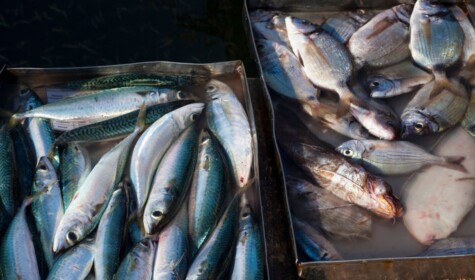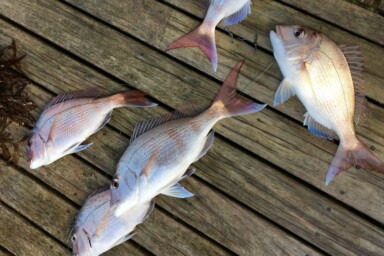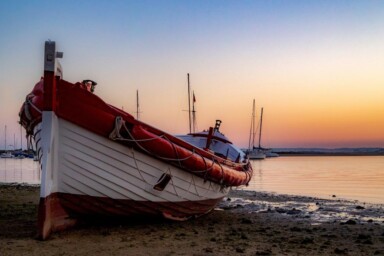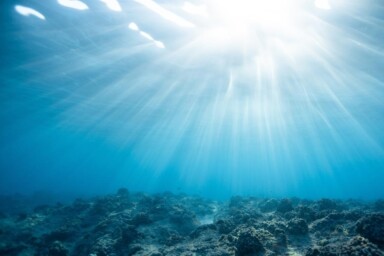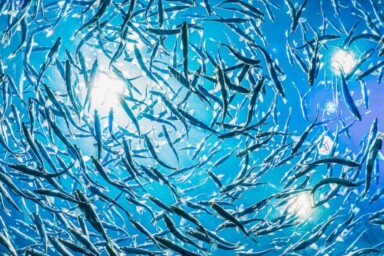Buying sustainably sourced fish is a priority for many people, but what ‘sustainable’ means in this context is incredibly complicated to navigate, with few clear ‘dos’ and ‘don’ts’. While the meat we eat comes from a few different species that can be identified and certified relatively easily, fish is a much more complex matter. There are a huge number of different species and each comes with their own sourcing issues and challenges. Buying your fish from a fishmonger gives you an opportunity to learn more about these challenges and ask questions about the seasonality and sourcing of the fish you’re buying.
As consumers, we are often nervous about asking questions in shops, but the more questions we ask, the more our fishmongers and retailers will realise that these issues are important to their customers; it’s an opportunity for us to help businesses create change from within the system. Importantly, in the case of sustainable fish, it’s also an opportunity to build a relationship with your fishmonger and find out more about these complicated issues.
Step 1: Understand the issues
Sourcing fish ‘sustainably’ is not a clear-cut subject. For many aspects, there isn’t a clear right and wrong – for example, net fishing isn’t always bad, and line fishing isn’t necessarily good. It depends on how the fishermen are using the nets, their accuracy in finding shoals and their speed at throwing back bycatch, among other things.
Fish farming is a complicated and contentious issue. In land-based farming we have seen a rise in agroecological practices in response to industrial agriculture, but we are yet to see a similar widespread response in fish farming. There are a few pioneering farms making waves, but most fish farms are hugely intensive in their production, with issues including overcrowding in ponds, a dependence on antibiotics and chemicals, environmental impact from feeding waste and effluence, and sustainability questions around what the fish are fed on. In short, it’s the equivalent to an industrially raised barn reared chicken.
So, what should we be eating? Locally caught fish such as herring, sardines and mackerel are often plentiful during certain seasons and can be a good start. Outside of that, try to eat a variety of fish – eating cod isn’t automatically bad, but try interspersing it with other fish such as coley or ling. Slow Food have some good principles based around their ‘Good, Clean and Fair’ guidelines.
Another thing worth contemplating is whether you are willing to back up your values with your wallet. Are you willing to pay the higher price and support your fishmonger in making the change to a better supply?
Step 2: Prepare your questions
Preparation is key. Think through the questions you ask, and how you will respond to the answers. What questions might you follow up with? What action will you take?
It’s good to begin the conversation by explaining that the ethical sourcing of your fish is important to you, and that’s why you’re asking these questions; also, mention that you understand it’s a complicated issue. This opens up the conversation, rather than leaving someone feeling confronted. If they don’t currently stock something, rather than criticising this, you can offer a positive incentive by offering that you would buy it, if they sold it.
The final point is to pick your moment and be respectful of the fishmonger’s time; they are running a business and all the pressures that come with that. A decent fishmonger should be willing to discuss the sourcing of their fish and you shouldn’t have to apologise for asking questions, but realise that a busy Saturday when there’s a queue of people to serve behind you, might not be the perfect moment. It’s polite to ask if they have time to chat or whether you can come back later, or perhaps if they would prefer you to email questions to them.
Step 3: The questions
These are designed as a starting point but should be shaped and adapted for your personal values.
Before asking questions, start with an observation exercise. First, look closely at the fish. Shiny eyes, a firm belly and slimy skin all indicate freshness.
Also, look for the variety of fish that they are selling. Is it just a few varieties and the ‘usual suspects’? If the range is small, it could be because stormy weather has restricted the fishing opportunities. However, it may also be that the fishmonger is lacking confidence that they can sell a wider range. A big, interesting counter with some lesser known varieties suggests a knowledgeable and passionate fishmonger.
Question 1: Can you suggest a fish for me to buy today? I’d like to try something different!
The most common fish that we eat – salmon, bass, tuna – are among the least sustainable in their fishing or production methods. Whether it’s depleted stocks of tuna caused by overfishing or the impact of the salmon and bass farms on the environment, these are fish we need to shift away from in our diet.
The way they answer this question should tell you a lot about their knowledge and interest in sustainable fishing. Farmed bass and bream are farmed in an intensive manner, but there are many other alternatives – a good fishmonger should be able to tell you that you could instead buy wild bream, gurnard or plaice. If you want your Omega 3s, instead of salmon, they could point you towards mackerel, herring or sardines. Or maybe offer lemon sole, coley or ling for a change.
Follow up questions could include: ‘What could I substitute instead of farmed bream or bass?’ ‘What are good alternatives to salmon?’
Question 2: What can you tell me about how and where your salmon is farmed?
Salmon is the most commonly eaten fish in the UK. However, most salmon you see in shops or restaurants is farmed – a contentious issue. From the routine use of chemicals to tackle parasites such as sea lice to the impact on the local environment of the excrement from the farm, it can be hard to find accurate information. The biggest issue when it comes to salmon farming though is what the salmon are fed. In many of the larger farms, a significant portion of the diet comes from fish such as sardines and anchovies, caught off the coast of South America and then fed to fish in farms in Scotland and Norway. This is an issue because it takes 2.5 – 5 kilos of wild fish to produce one kilo of farmed salmon, creating increased pressure on wild fish stocks. All salmon from large farms is likely to suffer from this issue.
Recently we’ve seen organic farmed salmon reach our fish counters. But there has been some public condemnation by experts in the field about these standards, with people claiming that though these improve on the sustainability of the diet of the fish, they don’t go far enough to create truly sustainable fish farming , with chemical use and overcrowding still prevalent.
There are some smaller farms working to farm in a more sustainable way, but perhaps the question should be about whether we are willing to switch out our salmon habit for other fish like mackerel?
Follow up questions include: ‘Do you know what the salmon are fed on?’ ‘Why do you source your salmon from this farm?’
Question 3: Can you tell me about the merchant(s) you buy your fish through?
Due to the size and scale of most fishmongers, they are likely to operate through a merchant rather than directly with fishermen, which means they have less ready access to information around how the fish was caught. However, there is traceability in the system, so it is worth asking if you have specific questions and your fishmonger should be able to find out.
Look at how the fishmonger has selected their merchants – where they are located; how long they have been buying from that merchant and why did they select them. There are some practical elements to this – frequency and timing of deliveries, for example – but where there are good local options you should expect them to be utilised. For example, it is reasonable to expect a Bristol-based fishmonger to be sourcing from a merchant in the South West.
Follow up questions include: ‘How long have you been buying fish through this merchant?’ ‘Why did you select them?’ ‘Where are they based?’
Question 4: How do the seasons affect what fish I should be eating right now?
Seasons and water temperatures have a significant effect on the fish we should eat. One aspect of this is because of migration, especially for fish such as sardines, herring and mackerel who are pelagic and therefore less tolerant of cold sea temperatures. This means they are only located in our local waters at certain times of the year, but when they are, there are usually large numbers of fish present. Traditionally sardines and mackerel are plentiful when the seas are warmer, and herring in the colder months, but the impact of climate change on sea temperatures is making this less clear cut.
The other thing to be aware of is the breeding cycles of fish. Ideally you shouldn’t catch fish when ‘in roe’ (when the fish are carrying their eggs before spawning), not only because it is removing the potential future stock from the oceans, but also because the meat quality is reduced during this time as the fish is putting their energy into the roe. Ideally a bit of time should be given afterwards to allow the muscle to build up again before eating the fish. You can find some helpful calendars online to guide you in this.
Follow up question: ‘What is seasonal right now?’
Question 5: Can you tell me about your tiger prawns and where they are from?
The farming of tiger prawns is incredibly intensive and destructive; standards are low and the environmental impact incredibly high. The largest supplier of prawns to Europe is the Thai fishing industry, an industry with evidence of slavery embedded in its supply chain, not to mention the wider issues of illegal land grabs and dispossession caused by the industry.
You can check out the helpful Prawn Guide put together by Greenpeace for more guidance about which prawns are ok to eat. There are more sustainable options available, though none are completely impact free – wild caught prawns from Argentina may not have the same local impact as farmed prawns, but they are shipped frozen the whole way to the UK, increasing their carbon footprint through the transportation.
Step 4: The review
The responses of your fishmonger should help give you a sense of whether he or she is on the right side of sourcing sustainable fish, and whether they can be trusted to make the right decisions when purchasing fresh fish. Building a trusting relationship with your fishmonger is important as they are well placed to help guide your future purchases.
How did you feel about the conversation? How were you treated? Were you satisfied with the answers you got? Do you need to do any further research? Would you buy fish from the fishmonger in the future? Was there anything you weren’t happy with? Do you feel like you trust them?
These are just some of the questions to ask yourself afterwards. Be prepared to do some further research – sustainable fish is a complicated issue and you will need to do more reading and research to understand the issues and make informed decisions.
Step 5: Further reading
There are some good general places to start – Slow Food have a comprehensive overview of the issues and some good clear guidelines; the Marine Conservation Society have a good fish guide with lots of information about specific species; and Greenpeace offer a good overview, including their more in-depth Prawn Guide. The Marine Stewardship Council – the blue label you often see on packets of fish – offer some helpful information but there is controversy over the label being applied to fish farms that are still deemed unsustainable.
For seasonality, the Fish and Season website has a helpful calendar; and regarding bycatch, Hugh’s Fish Fight is a campaign working to end discards.
This article was co-authored with Joe Wheatcroft.
Joe has worked for 20 years in many aspects of the food business, from organic pig farming to washing dishes in fine restaurants. Working on farms both here in the UK and in Denmark has been really valuable when it comes to understanding the nuts and bolts of how the food is produced. He has worked in many of Bristol’s food establishments including Southville Deli, Radford Mill Farm Shop, Fishworks and Taste, and is now the co-owner, shop manager and fishmonger at the Source Food Hall and Cafe. He loves what food does to people and he doesn’t just mean the nutrients.
